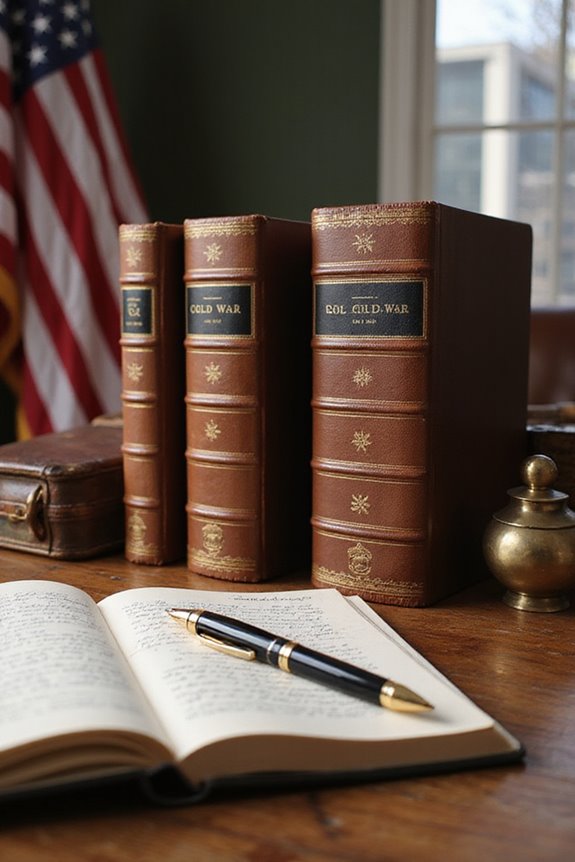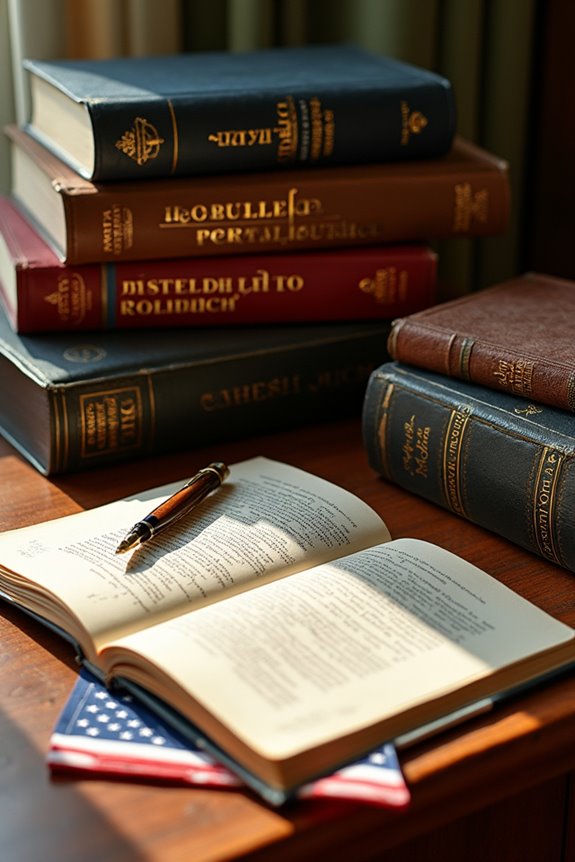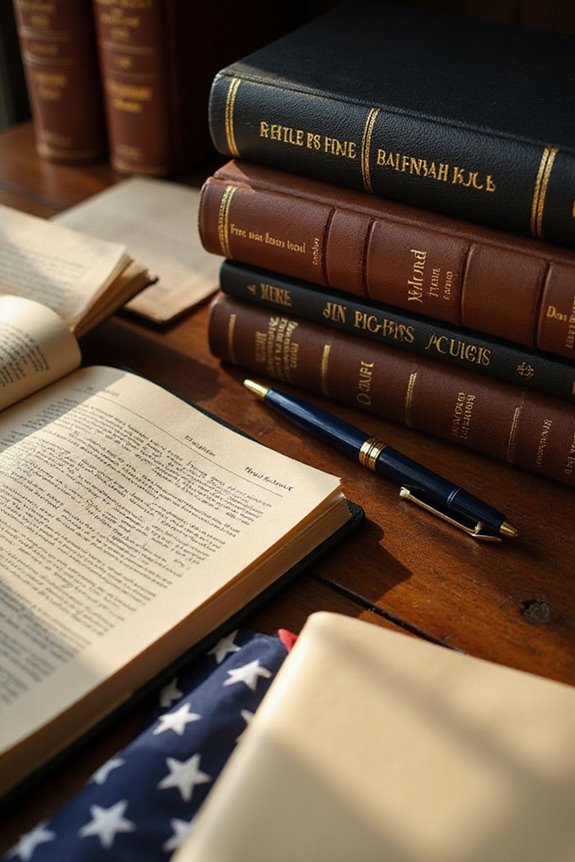We’ve identified several top political books on the Cold War that offer valuable insights into its complexities. Key titles include:
- John Lewis Gaddis’s *Strategies of Containment*, detailing U.S. strategies.
- *The Cambridge History of the Cold War*, which examines economic and ideological factors.
- Archie Brown’s *The Human Factor*, focusing on leadership’s role.
These works enhance our understanding of the geopolitical dynamics and ideological struggles of the era. There’s more to explore, shedding light on the Cold War’s lasting implications.
Key Takeaways
- *Strategies of Containment* by John Lewis Gaddis outlines U.S. national security policy and strategies during the Cold War.
- *The Cold War: A New History* by Gaddis revises interpretations using newly uncovered archives for deeper insights into the conflict.
- *The Cambridge History of the Cold War* examines economic and ideological factors shaping the Cold War’s dynamics and global impact.
- Archie Brown’s *The Human Factor* emphasizes the role of leadership and human agency in shaping Cold War events and outcomes.
- Hal Brands’ *Lessons from the New Cold War* highlights contemporary geopolitical tensions and the relevance of Cold War lessons for modern conflicts.
Essential Political Perspectives
Understanding the essential political perspectives of the Cold War requires us to examine the ideological foundations and political alignments that defined this period.
- The Cold War was marked by significant ideological divides between capitalist democracies, led by the United States, and communist states, led by the Soviet Union.
- Post-WWII conferences, such as Yalta and Potsdam, failed to reconcile these conflicting political objectives, leading to mistrust. Historical context reveals how these events contributed to the deepening divide.
- The Soviet Union’s control over Eastern Europe reinforced this divide, as it opposed Western democratic ideals.
- Political strategies included the U.S. focus on containment of communism, which aimed to limit its expansion through military alliances.
- Additionally, the formation of military alliances, like NATO and the Warsaw Pact, structured international relations and forced nations to align ideologically.
Leadership and Political Agency

The ideological divides of the Cold War were mirrored in the leadership dynamics that shaped its course. Key leaders, like Stalin and Gorbachev, exemplified contrasting political narratives.
- Stalin’s aggressive postures initiated the Cold War, while Khrushchev’s thaw showcased fluctuating openness.
- Brezhnev maintained rigid control, yet Gorbachev’s reforms marked a notable ideological shift, promoting glasnost and perestroika. Gorbachev’s ‘New Thinking’ represented a significant departure from previous policies. Contemporary political theories often emphasize the importance of leadership in navigating complex geopolitical landscapes.
- Leaders such as Reagan and Thatcher played vital roles, emphasizing negotiation over military conflict.
These dynamics highlight how effective leadership required adaptability and political agency, rather than mere dominance. Archie Brown argues that political qualities, like coalition-building and vision-setting, were paramount to success. Ultimately, the interplay of these leadership styles notably influenced the Cold War’s de-escalation and resolution.
Foundational Cold War Histories
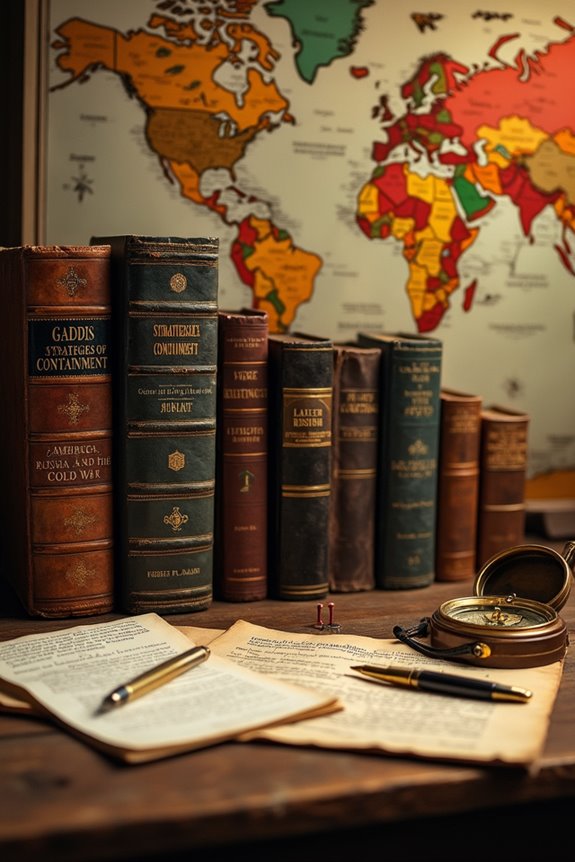
Foundational Cold War histories provide critical insights into the complex interplay of global politics during this pivotal period.
- *Strategies of Containment* by John Lewis Gaddis outlines U.S. national security policy, emphasizing Cold War dynamics and presidential strategies. This work illustrates the importance of political theories that shaped national responses to global conflicts.
- The edited volume Origins of the Cold War: An International History traces the ideological roots of the conflict.
- Gaddis’s The Cold War: A New History revises interpretations using newly uncovered archives.
- *The Cambridge History of the Cold War* offers a thorough examination of economic and ideological factors.
- The Cold War International History Project broadens perspectives by incorporating archives from former Communist states, enhancing our understanding of geopolitical strategies. Additionally, the fall of the Berlin Wall marked a significant moment in the Cold War, symbolizing the collapse of Soviet influence in Eastern Europe.
These texts collectively shape our comprehension of the Cold War and its lasting implications on global relations.
Recent Scholarly Contributions

As we explore recent scholarly contributions to Cold War studies, we find that new perspectives enrich our understanding of this complex period. Importantly, Archie Brown’s *The Human Factor* emphasizes the role of Cold War leadership, highlighting how figures like Gorbachev and Reagan influenced the conflict’s resolution. This work, which won the 2021 Pushkin House Prize, argues that political strategies were vital, beyond mere military might. Other significant texts include Odd Arne Westad’s *The Cold War: A World History* and Melvyn P. Leffler’s *For the Soul of Mankind*, which further examine US-Soviet relations. Additionally, Hal Brands’ *Lessons from the New Cold War* connects past dynamics to current geopolitical rivalries, providing essential insights into the ongoing global landscape. The importance of archival evidence in testing theoretical concepts is also a significant aspect of recent Cold War scholarship. Moreover, understanding the foundational concepts of political economy can offer deeper insights into the economic motivations behind Cold War policies.
Thematic Interpretations in Cold War Literature
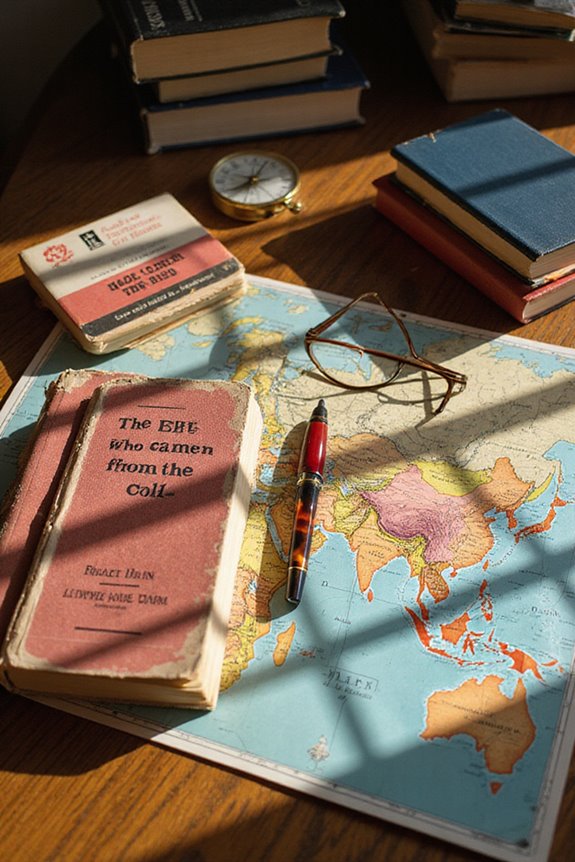
Thematic interpretations in Cold War literature reveal a rich tapestry of societal concerns, reflecting the anxieties and ideologies of the era. Key themes include:
- Paranoia Themes: Many novels depict paranoia as a natural response to instability, showcasing surveillance and distrust. Works like Thomas Pynchon’s *The Crying of Lot 49* exemplify this through complex conspiracies that challenge reality. This sense of paranoia can be traced back to the broader context of democratic backsliding, as fears of authoritarianism loomed large during the period.
- Conformity Struggles: Authors frequently explore the tension between individual freedom and societal pressure. Sloan Wilson’s *The Man in the Gray Flannel Suit* critiques the conformity expected during the Cold War, revealing conflicts faced by individuals balancing personal aspirations with ideological loyalty. This struggle is further complicated by the overarching influence of containment policy, which sought to limit any perceived threats to American ideology. The pressures of conformity often resulted in individuals feeling alienated, as seen in various narratives that highlight the psychological toll of adhering to societal expectations.
These narratives effectively illustrate the underlying fears and societal dynamics of Cold War America, encompassing both paranoia and conformity.
Recommended Reading Lists and Recognition
When exploring recommended reading lists and recognition for political books about the Cold War, we find a wealth of influential titles that offer critical insights. Notable selections include:
- *The Human Factor* by Archie Brown, winner of the 2021 Pushkin House Prize, emphasizing leadership.
- *The Cold War: A World History* by Odd Arne Westad, providing a thorough overview.
- *Strategies of Containment* by John Lewis Gaddis, foundational for understanding American policy.
Many of these works receive academic accolades and critical reviews, ensuring their place in scholarly discussions. Institutions like Harvard and Oxford University Press endorse these texts, enhancing their credibility. Additionally, edited volumes often feature diverse perspectives, reflecting the complex nature of Cold War politics. The Cold War’s legacy continues to shape current international relations, making these texts essential for understanding its lasting impact.
Frequently Asked Questions
What Are the Main Causes of the Cold War?
The Cold War stemmed from ideological differences between communism and democracy, alongside the nuclear arms race. These conflicts fostered distrust, leading us into a prolonged period of rivalry and geopolitical tension that shaped global relations.
How Did the Cold War Affect Global Politics Today?
We can’t ignore the Cold War’s shadow over today’s global politics. Its legacy fuels nuclear proliferation and shapes international alliances, creating a precarious balance that influences our world in ways we’re just beginning to understand.
What Role Did Propaganda Play During the Cold War?
During the Cold War, we saw propaganda techniques shape opinions through media influence, promoting fears and ideological divides. These campaigns crafted narratives that not only informed but manipulated our perceptions of the opposing bloc considerably.
How Did Cultural Exchanges Influence Cold War Relations?
Did you know around 50,000 Soviets visited the U.S. between 1958 and 1988? These cultural exchanges fostered artistic collaboration and served as effective cultural diplomacy, improving Cold War relations by humanizing each side’s perspectives and reducing tensions.
What Were the Key Events Leading to the Cold War’s End?
We can see that key events like diplomatic negotiations, the signing of arms control treaties, and the imposition of economic sanctions played essential roles in easing tensions, ultimately leading to the Cold War’s end and transforming global dynamics.

